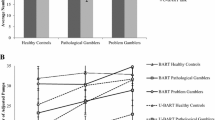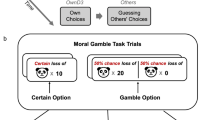Abstract
Orthodox expected utility theory imposes too stringent restrictions on what attitudes to risk one can rationally hold. Focusing on a life-and-death gamble, I identify as the main culprit the theory’s Linearity property, according to which the utility of a particular change in the risk of a bad outcome is independent of the original level of risk. Finally, I argue that a recent non-standard Bayesian decision theory, that does not have this property, handles risky gambles better than the orthodox theory.



Similar content being viewed by others
Notes
It might be worth clarifying that the assumption (which I shall later relax) is that you judge now that it makes no difference whether you leave any money behind when you pass away. The assumption is not, of course, the more trivial one that once you are dead you don’t value money (nor anything else, for that matter).
Kahneman and Tversky (1979) seem to have been the first to discuss this example in print, but they attribute it to Richard Zeckhauser (which is why it is sometimes referred to as ‘Zeckhauser’s paradox’). As far as I can tell, the only philosophers who have discussed Zeckhauser’s paradox in any detail are Richard Jeffrey (1988) and Howard Sobel (1989).
For those who find their life barely worth living, t may be just a few microseconds. And for those with a death wish, t may be negative (meaning that they would be willing to endure some torture not to have the bullets removed).
This example was suggested to me by Sven Ove Hansson.
Someone might object that the difference between what is learned in the two examples has got nothing to do with the intrinsic (un)desirability of risks and chances. Rather, the difference is that in the first case, but not in the second, you will have made plans on the assumption that the play will not be canceled. To avoid such objections, we can imagine that you learn the information after having seen the play (or after learning that it was canceled). I suspect that in this version of the example, you would also find the news less undesirable, or less outrageous, in the second case, where you already knew from the start that you were taking a chance.
Another potential source of complication is that one might think that in one case one is learning something about the nature of the theater company or their procedures that one is not learning in the other example. (I thank a Topoi referee for bringing this to my attention.) So, to keep the example as clean as possible, let’s suppose that you don’t learn or infer anything about the reasons or causes for the chances of cancellation in either case.
The papers in which the theory in question is developed does not discuss Zeckhauser’s paradox. Thanks to a Topoi referee for encouraging me to emphasize this.
Note that the claim is not that Buchak’s theory, or other non-standard utility theories, cannot rationalize paying more in the second scenario than in the first. The main differences between the theory employed in this paper and other non-standard utility theories—in particular, risk-weighted expected utility theory, prospect theory, and rank-dependent utility theory—are discussed in detail in Stefánsson and Bradley (2017), and are briefly discussed in the closing section of this paper.
Similarly, we are assuming that you cannot be tortured after your death. To keep things simple, I will focus on monetary transactions for the remainder of this paper. But what I say about money also holds for, say, minutes of torture.
More generally, X and Y can stand for any good such that you would be indifferent between giving up that good in exchange for improving your chances in the two scenarios and taking your chances with the greater risk. This remark applies for the remainder of this paper.
This assumption is not essential to the argument. For instance, those who would be willing to pay to avoid reducing their risk of dying (i.e., those for whom X and Y have a negative value) should also, according to expected utility theory, ‘pay’ the same in the two scenarios.
If you don’t care at all about how much money you have, then we can change this to: assuming that you care about how much you are tortured.
From now on, I will use ‘gamble’ and ‘lottery’ interchangeably as meaning any prospect that gives rise to an objective probability distributions over a set of outcomes (or ‘prizes’).
Why are we assuming that \(L_2\sim P_X\)? Recall that X is chosen such that \(L_1\sim L_2\). But \(L_1\) is a ‘lottery’ that is guaranteed to result in \(P_X\) Thus \(L_1\) and \(P_X\) offer the same probability for each of it’s possible outcomes, so by Reduction, \(L_1\sim P_X\), which by Transitivity of indifference means that \(L_2\sim P_X\).
Whether or not such a Humean philosophy is consistent with a violation of Linearity (and Chance Neutrality; Stefánsson and Bradley 2015) when it comes to subjective probabilities is a question I will leave open in this paper.
Some defend expected utility theory by pointing to certain dynamic advantages of following the prescriptions of the theory and/or defend the theory as formalizing consequentialist practical reasoning. See e.g. Hammond (1988a, b); see also McClennen (1990) for a detailed discussion. If these arguments are sound, then paying the same amount in the two versions of the Russian roulette is irrational. In particular, an agent with such a preference can find herself in a dynamic choice situation where she will for sure end up worse off (by her own lights) than she would have done, had her preferences been in line with orthodox expected utility theory.
All alternatives to orthodox expected utility theory have to respond to the above arguments. One option is to say that violating the norms of consequentialism and rational dynamic choice is an acceptable cost in light of the benefits of avoiding Zeckhauser’s paradox and other similar problems that the orthodox theory runs into. Alternatively, one can find a different formulation of consequentialism and defend “non-orthodox” dynamic choice rules, as e.g. McClennen (1990) and Rabinowicz (1995) have done. I personally favor the latter option, but since I have nothing of substance to add to the already quite extensive literature on this issue, I will not discuss it further.
I call a decision theory ‘Bayesian’ if the expectation whose value a rational agent maximizes is calculated relative to her own subjective (as opposed to objectively given) probabilities. Thus Leonard Savage’s (1954) and Richard Jeffrey’s (1965) decision theories are Bayesian, but von Neumann and Morgenstern’s (1944) is not.
Hence, the person’s preferences is linear in subjective, but not necessarily objective, probabilities.
Since the distinction between objective and subjective probabilities makes no difference to the argument of this paper, I do not formalize subjective probabilities here; all probabilities discussed here are meant to be objective (and it is assumed that the decision-maker adopts these as her subjective probabilities). I thank a referee for Topoi for encouraging me to clarify this.
Strictly speaking, the neutrality of chances only entails Linearity in the presence of the Principal Principle (Lewis 1980), according to which one’s credence should be guided by one’s expectation of chance. But unlike the assumption of chance neutrality, the Principal Principle is almost universally accepted.
The function is not as complicated as it might seem, since the division is only there to ensure that the utility of staying alive for sure is 1, in keeping with the previous normalization of the utility function.
See Stefánsson and Bradley (2017) for a further discussion of this feature of the theory.
Some may find the possible failure of Reduction to be a sufficient reason to not reject Linearity. However, this is, I think, a bullet one should simply bite, if one accepts the argument of this paper.
I thank a referee for Topoi for encouraging to add this section.
Stefánsson and Bradley (2017) discuss some experimental evidence that suggests that people do have such attitudes.
References
Allais M (1953) Le comportement de l’homme rationnel devant le risque: Critique des postulats et axiomesde l’ecole Americaine. Econometrica 21(4):503–546
Anscombe FJ, Aumann RJ (1963) A definition of subjective probability. Ann Math Stat 34(1):199–205
Bernoulli D (1954/1738). Exposition of a new theory on the measurement of risk. Econometrica 22(1):23–36
Binmore K (2009) Rational decisions. Princeton University Press, Princeton
Bolker ED (1966) Functions resembling quotients of measures. Trans Am Math Soc 124(2):292–312
Bradley R, Stefánsson HO (2017) Counterfactual desirability. Br J Philos Sci 68(2):485–533
Buchak L (2013) Risk and rationality. Oxford University Press, Oxford
Ellsberg D (1961) Risk, ambiguity, and the Savage axioms. Q J Econ 75(4):643–669
Hammond P (1988a) Consequentialism and and the Independence axiom. In: Munier B (ed) Risk, decision and rationality. Springer, New York
Hammond P (1988b) Consequentialist foundations for expected utility theory. Theory Decis 25(1):25–78
Jeffrey R (1965) The logic of decision. The University of Chicago Press, Chicago
Jeffrey R (1988) Biting the bayesian bullet: Zeckhauser’s problem. Theory Decis 25(2):117–122
Kahneman D, Tversky A (1979) Prospect theory: an analysis of decision under risk. Econometrica 47(2):263–292
Lewis D (1980) A subjectivist’s guide to objective chance. In: Jeffrey RC (ed) Studies in inductive logic and probability. University of California Press, Berkeley
Loomes G, Sugden R (1982) Regret theory: an alternative theory of rational choice under risk. Econ J 92:805–824
McClennen EF (1990) Rationality and dynamic choice: foundational explorations. Cambridge University Press, Cambridge
Rabinowicz W (1995) To have one’s cake and eat it, too: sequential choice and expected-utility violations. J Philos 92(11):586–620
Savage L (1954) The foundations of statistics. Wiley, Hoboken
Sobel JH (1989) Utility theory and the Bayesian paradigm. Theory Decis 26(3):263–293
Stefánsson HO (2014) Risk and rationality by Lara Buchak. Econ Philos 30(2):252–260
Stefánsson HO, Bradley R (2015) How valuable are chances? Philos Sci 82(4):602–625
Stefánsson HO, Bradley R (2017). What is risk aversion? Br J Philos Sci. doi:10.1093/bjps/axx035
von Neumann J, Morgenstern O (2004/1944) Games and economic behavior (Sixtieth-anniversary ed.). Princeton University Press, Princeton
Acknowledgements
This paper has been presented at the Philosophy Staff Seminar at Monash University, the Higher Seminar in Practical Philosophy at Uppsala University, the Ethics and Uncertainty Workshop organized by the Stockholm Centre for the Ethics of War and Peace, and New Trends in Rational Choice Theory at MCMP in Munich. I am grateful to the participants for helpful comments, questions and suggestions. Thanks also to Gustaf Arrhenius, Richard Bradley and Timothy Campbell for helpful comments on an earlier version of this paper.
Author information
Authors and Affiliations
Corresponding author
Rights and permissions
About this article
Cite this article
Stefánsson, H.O. Gambling with Death. Topoi 39, 271–281 (2020). https://doi.org/10.1007/s11245-017-9519-z
Published:
Issue Date:
DOI: https://doi.org/10.1007/s11245-017-9519-z




